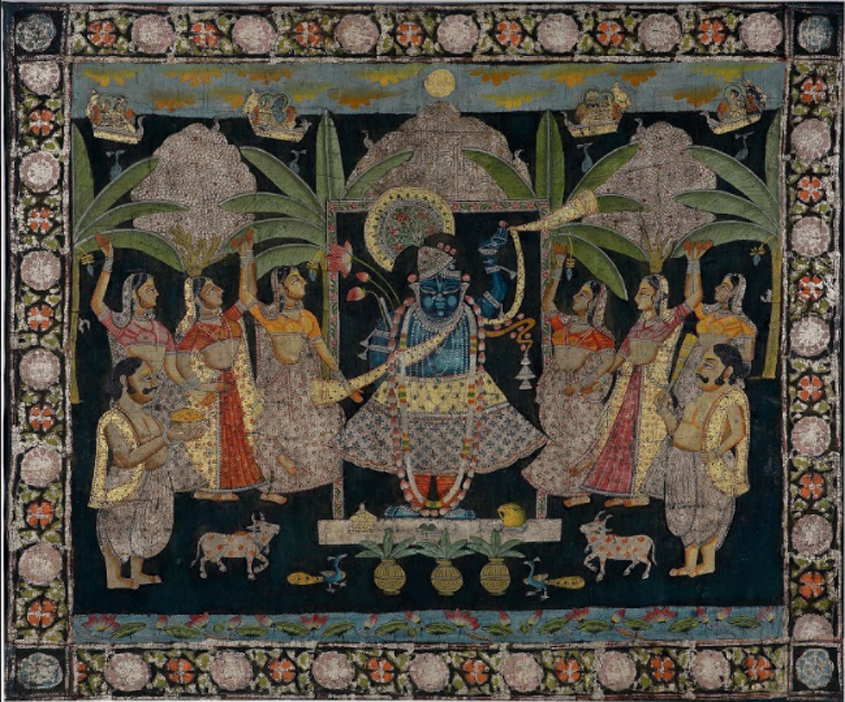At the Kochi-Muziris Biennale 2016, visitors will get a chance to explore an exhibition of contemporary interpretations of Pichvai works that, for the first time, will bring this traditional Indian art form into a nascent new avatar. Opening on the 14 December 2016, the exhibition will run through to March 2017.
Pichvai Tradition & Beyond — A Collateral Project at Kochi-Muziris Biennale 2016 is an official collateral event to the Biennale, notably South Asia’s largest international art exhibition held in the old trading port of Fort Kochi, Kerala. Applying this traditional art form in a more contemporised style to a prestigious international platform such as the Biennale, will propel Pichvai art to the centre of contemporary artistic engagement and enable new audiences to understand and appreciate the sublime beauty that these works are invested with.
A Pichvai is a luxuriously detailed hand-painted textile traditionally hung behind the idol of Shrinathji, an incarnation of Lord Krishna. Worshipped by the Vaishnavite sub-sect of the Pushtimargis, the small temple town of Nathdwara, near Udaipur in Rajasthan, is home to the shrine. Over the last century, intricately painted Pichvai paintings that left the shrine have taken on a new role as wall art and are much sought after by the cognoscenti for their effervescent aesthetics, inciting a fresh demand among collectors. The evocative nuances of this deceptively simple painting style hides layers of spiritual significance, symbolism and varied visual imagery depicting the many seasons and moods of Lord Krishna through the year. Over the last century, traditionally trained artists have reproduced many celebrated artworks of the genre, but while the innovations did occur, they were either individual commissions dictated by the aesthetics of involved patrons or custom made to fit personal shrines.
Whilst such traditional religious observations are still commonplace today, Pichvai art is in the process of undergoing a renaissance, owing to the committed efforts and innovations of Pooja Singhal, who, through her company Pichvai Tradition & Beyond, has both championed and contemporised the art form in order to create a more accessible market for younger generations and contemporary cultural consumers.
A Pichvai is a luxuriously detailed hand-painted textile traditionally hung behind the idol of Shrinathji, an incarnation of Lord Krishna.
Recognising the need to create a platform to support and sustain the few remaining supremely skilled painters who learnt the rapidly declining tradition from a long line of past masters, Pooja Singhal created the Pichvai Tradition & Beyond atelier. Unencumbered by the weight of tradition, whilst respecting and preserving the original forms, such artists have now merged long-established practices with contemporary interventions, to create new interpretations of works that not only move away from inherent historic religious undertones, but are reworked to incorporate new modes of scale, colour, form and theme. Contemporising such art forms to enable them to capture alternate audiences is critical to preserving their rich heritage as well as to sustaining the livelihoods of artisans.
Commenting on the exhibition, Curator, Pramod Kumar KG says: “For traditional arts to have a resonance and relevance to contemporary audiences, they constantly need to be re-interpreted and contextualised for the here and now. Pooja Singhal’s ‘Pichvai Tradition & Beyond’ has for the first time brought to the public eye, artworks that have been reworked with layered historical inferences in newer scales, formats and themes. These artworks thus have moved away from their purely religious connotations to representations of aesthetic modes, seasons, forms, colours and secular iconographies that every layperson can see and appreciate. While these artworks have found newer patrons, the true success of the project has been the inculcation of a fresh group of artists in this time-honored genre who have given new life into an old art form by merging older traditional techniques with contemporary application and ingenuity.”

